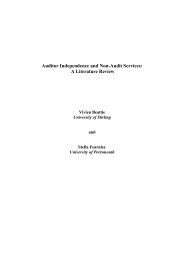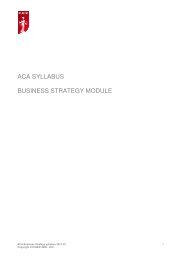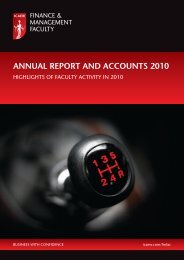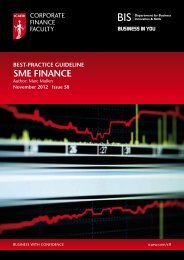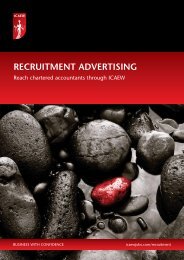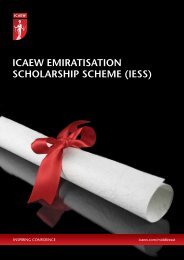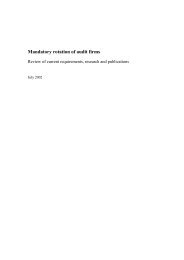Acting in the public interest â a framework for analysis - ICAEW
Acting in the public interest â a framework for analysis - ICAEW
Acting in the public interest â a framework for analysis - ICAEW
- No tags were found...
Create successful ePaper yourself
Turn your PDF publications into a flip-book with our unique Google optimized e-Paper software.
Our <strong>framework</strong> is based around <strong>the</strong> key issues that need to be addressed by those who arefac<strong>in</strong>g <strong>the</strong> challenge of justify<strong>in</strong>g actions as be<strong>in</strong>g <strong>in</strong> <strong>the</strong> <strong>public</strong> <strong>in</strong>terest. The <strong>framework</strong> coversa number of stages:• justification of credentials <strong>for</strong> <strong>the</strong> right to <strong>in</strong>voke <strong>the</strong> <strong>public</strong> <strong>in</strong>terest;• identification of whe<strong>the</strong>r a matter is actually a <strong>public</strong> <strong>in</strong>terest matter;• consideration of who <strong>the</strong> relevant <strong>public</strong> are, what <strong>the</strong>y want and whe<strong>the</strong>r <strong>the</strong>ir wantscontrast with needs or o<strong>the</strong>r constra<strong>in</strong>ts;• aggregation of sometimes conflict<strong>in</strong>g <strong>in</strong>put and result<strong>in</strong>g decision; and• implementation of <strong>the</strong> desired action.This report is relevant to <strong>the</strong> accountancy profession and more broadly. It considers allcircumstances <strong>in</strong> which organisations seek to change people’s actions through laws, regulationsor o<strong>the</strong>r methods of persuasion. In this context <strong>the</strong> <strong>framework</strong> should be useful to anyone asa tool <strong>for</strong> challenge and relevant to any of <strong>the</strong> wide range of actions that are asserted to be <strong>in</strong><strong>the</strong> <strong>public</strong> <strong>in</strong>terest. However, <strong>the</strong> <strong>framework</strong> also has a role <strong>for</strong> <strong>in</strong>dividuals consider<strong>in</strong>g an actionsuch as disclosure of a matter that would o<strong>the</strong>rwise be confidential, <strong>in</strong> <strong>the</strong> <strong>public</strong> <strong>in</strong>terest. In somecircumstances, transparency requirements will be lower <strong>for</strong> an <strong>in</strong>dividual undertak<strong>in</strong>g his or herown action than <strong>for</strong> an organisation advocat<strong>in</strong>g change <strong>in</strong> o<strong>the</strong>rs’ behaviour, but scepticismabout motive is still appropriate and <strong>the</strong> same pr<strong>in</strong>ciples and questions can be applied.The true measure of whe<strong>the</strong>r someone is act<strong>in</strong>g <strong>in</strong> <strong>the</strong> <strong>public</strong> <strong>in</strong>terest lies <strong>in</strong> <strong>the</strong> confidence ofthose affected, not those mak<strong>in</strong>g <strong>the</strong> pronouncements. There<strong>for</strong>e <strong>the</strong> need <strong>for</strong> those assert<strong>in</strong>gthat <strong>the</strong>y are act<strong>in</strong>g <strong>in</strong> <strong>the</strong> <strong>public</strong> <strong>in</strong>terest to consider actual and perceived threats to fitnessto decide, and <strong>the</strong> application of relevant safeguards, will apply throughout <strong>the</strong> process. Theway a <strong>public</strong> <strong>in</strong>terest action is determ<strong>in</strong>ed, and seen to be determ<strong>in</strong>ed, and <strong>the</strong> <strong>public</strong> <strong>in</strong>terestappropriateness of <strong>the</strong> solution, will <strong>in</strong>fluence <strong>the</strong> acceptance of <strong>the</strong> measure. This will <strong>in</strong> duecourse affect <strong>the</strong> reputation of those implement<strong>in</strong>g <strong>the</strong> action and that, <strong>in</strong> turn, will help withfuture acceptance and implementation.1.4 The <strong>framework</strong>The stages <strong>in</strong> <strong>the</strong> <strong>framework</strong> <strong>in</strong>teract and <strong>the</strong> whole process is iterative. The diagram belowand <strong>the</strong> summaries that follow it set out <strong>the</strong> seven key areas to be considered <strong>in</strong> mak<strong>in</strong>g <strong>the</strong>assessment:Figure 1: Public <strong>in</strong>terest <strong>framework</strong>Credentials <strong>for</strong><strong>in</strong>vok<strong>in</strong>g <strong>the</strong><strong>public</strong> <strong>in</strong>terestImplementationApplicability of<strong>the</strong> <strong>public</strong><strong>in</strong>terestAggregation anddecision<strong>Act<strong>in</strong>g</strong> <strong>in</strong><strong>the</strong> <strong>public</strong><strong>in</strong>terestThe relevant<strong>public</strong>Constra<strong>in</strong>ts towantsThe relevant<strong>public</strong>’s wantsSummary: a <strong>public</strong> <strong>in</strong>terest <strong>framework</strong>05



